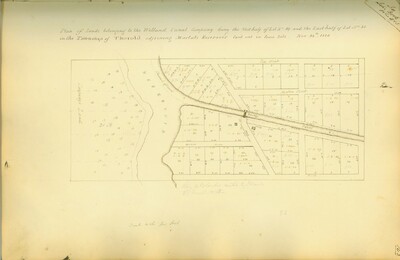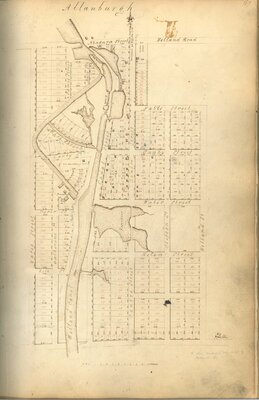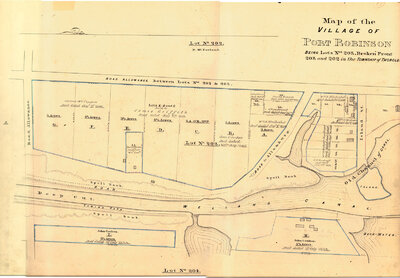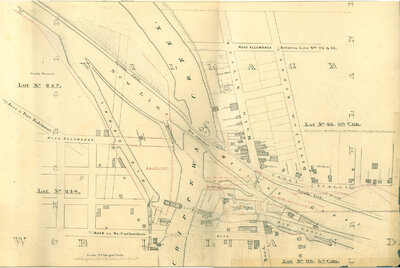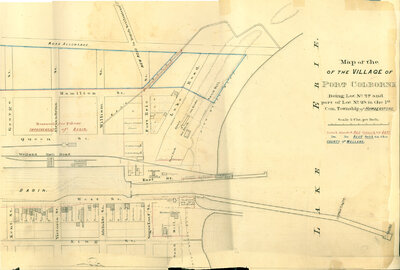Communities
Many communities in Niagara developed as a result of the construction and operation of the Welland Canal. Some of Niagara's communities existed before the canal, but thrived because of it. A closer look at some of these communities follows, including Port Dalhousie, Merritton, Thorold, Allanburg, Port Robinson, Welland, and Port Colborne. The plans shown on this page are part of the Welland Canal / St. Lawrence Seaway Authority fonds.
Port Dalhousie
Port Dalhousie developed around 1826 as a result of the canal. Initially there seemed to be a distinction made between the Village of Dalhousie and the port. The port was commonly known as Welland Canal Harbour, Dalhousie Harbour, or Harbour at 12 Mile Creek. By the end of 1827, Port Dalhousie was more commonly being used to describe both the port and the village. The name is derived from George Ramsay, the 9th Earl of Dalhousie. He was the Governor-in-Chief of British North America from 1820 to 1828 and a strong supporter of the Welland Canal.
Merritton
Merritton did not formally acquire its name until 1869. Its early roots come from the establishment of Centreville around 1826, named because of its location half way between Lake Ontario and the Welland River. During the construction of the second canal, the area became known as Slabtown as a result of the wooden shanties canal workers built for themselves on nearby government land. Another settlement developed in this area in the early 1850s when the Welland Canal Loan Company created a new town called Welland City. The areas of Centreville and Welland City were then named Merritton in 1869 in honour of William Hamilton Merritt. Merritton became part of the City of St. Catharines in 1961.
Thorold
Thorold developed as a result of the canal and George Keefer, first President of the Welland Canal Company. George and his son, George Junior, roughly laid out a plan for the village of Thorold around 1828. The name was derived from the existing township. Thorold Township was named in 1793 in accordance with Governor Simcoe's county-based naming policy. This stipulated that all counties in Upper Canada west of the Trent River be named after English counties.
Allanburg
Allanburg was originally known as Deep Cut. This was where the ground was excavated between Beaver Dams and the Welland River, and the village developed as a result. Stores and taverns opened to serve the canal workers and Thorold's post office moved there in 1827. That same year, the Welland Canal Company bought land in the area and laid out building lots. By 1830, the village was known as Allanburgh. It was named after William Allan, Vice President of the Canal Company and President of the Bank of Upper Canada.
Port Robinson
Port Robinson was originally called Beverley. Both "Beverley" and "Port Robinson" honour John Beverley Robinson, Attorney General of Upper Canada and a director of the Welland Canal Company. By 1831, it was commonly known as Port Robinson. The village was located at the south end of the Deep Cut where the Welland Canal met the Welland River, and developed as a result of the construction of the canal. In 1830, the Welland Canal Company purchased land in the area and laid out building lots. During the development of the second Welland Canal, Port Robinson was a commercial hub with a thriving shipbuilding industry.
Welland
Welland began in 1829 as a shanty town next to the aqueduct that carried the feeder canal over the Welland river. The community was slow to develop and no mills were built in the area until the completion of the second Welland canal in 1845. It was originally known simply as Aqueduct, but the name was changed to Merrittville (in honour of William Hamilton Merritt), in 1844. In 1858, the community was incorporated as a village and became known as Welland. Welland was incorporated as a town in 1878 and as a city in 1917.
Port Colborne
First known as Gravelly Bay, Port Colborne was chosen as the terminus of the Lake Erie extension of the Welland canal. In 1831, it was commonly referred to as Port Colborne, named after Sir John Colborne, Lieutenant Governor of Upper Canada from 1829 to 1836. Colborne played an important role in securing financing for the extension of the Welland Canal to Lake Erie. The development of the community was delayed due to land ownership problems. But by 1834, William Hamilton Merritt had purchased land and established building lots. It was incorporated as a village in 1870. Port Colborne became a town in 1918 and a city in 1967.
Additional Resources
The communities of the "first" first Welland Canal / Alun Hughes SPCL FC 3155.4 H84 no. 6
The feeder canal and its communities / Alun Hughes SPCL FC 3155.4 H84 no. 7
Four Welland Canals, the St. Lawrence Seaway and their canal communities / John N. Jackson, Canadian Canal Society. SPCL FC 3143.5 J336 1992
The Welland Canals and their communities: engineering, industrial and urban transformation / John N. Jackson. SPCL FC 3143.4 J336 1997
Community Builders: history of the Welland Canal and the St. Lawrence Seaway, 1962. SPCL FC 3163.4 K59 1962
A brief history of Thorold and Guide to the Welland Canal / Thorold Kiwanis Club. SPCL FC 3163.4 K59 1973
Port Robinson: Welland Canal 160th Anniversary, 1979. SPCL FC 3159 P7 M524
The Historic Welland Canals at Port Colborne. SPCL 3143.4 M55 2004

